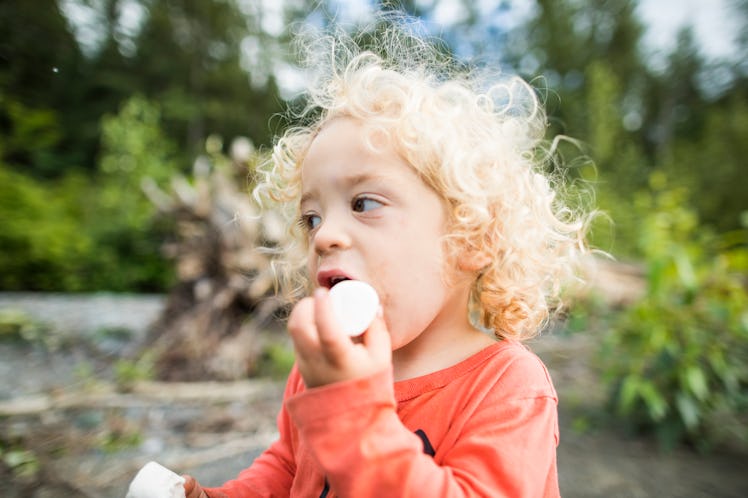Why You Don't Need To Worry If Your Kid Fails The Marshmallow Test
Succumbing to temptation once doesn’t mean they always will.

The marshmallow test is back. You know the one: A child is presented with a marshmallow and told that they can choose to either eat it now or wait 15 minutes to eat it and be given an additional marshmallow. The test, first developed by psychologist Walter Mischel at Stanford in the late 1960s, has long been invoked as a sort of crystal ball, providing insight into a child’s lifelong capacity for not only resisting instant gratification but for the self-discipline required to achieve educational and professional success.
This idea has only proliferated in the decades since, leading eventually, as most things do, to a TikTok trend. Recent months have seen a wave of videos featuring ring-lit toddlers instructed not to eat until their parent returns, left alone with a favorite treat and a camera. In a certain circle of the parent Internet, the trend has led to parodies, which has led to in-depth discussion videos. But there’s one important thing all these videos are missing, and that’s the fact that most of us are wrong about what the marshmallow test actually indicates.
Mischel’s original study, published in 1970, had the self-stated objective of investigating the development of self-regulatory behavior. Famous follow-up studies of his initial cohort of preschoolers showed correlations between performance on the marshmallow test and certain measures of social and emotional success in academic and professional settings. The studies offered little more than speculation about the potential causes of these seemingly linked findings — after all, they weren’t designed to — but the idea that a child’s ability to self-regulate might have a predetermined cap was enough to captivate the public.
However, this deterministic idea is a far-reaching oversimplification of human behavior. “The marshmallow test has been oversold in the media,” says Alex Wellsjo, Ph.D., a postdoctoral economist at the University of California, Berkeley’s Haas School of Business, who worked alongside Mischel’s team on the latest follow-up study of his original cohort. “The original studies actually show that self-regulation is not a persistent trait — that it’s going to depend not only on the person but on the situation.” Wellsjo says that Mischel, who passed away in 2018, understood that his contribution to psychology was not fortune-telling for 4-year-olds, but demonstrated proof that “self-regulation is important, but it’s something that can fluctuate.”
This fluctuation is most apparent in this latest study, a 2020 look at Mischel’s original cohort, now in their 40s. For the study, 113 of the original marshmallow munchers were evaluated based on a number of factors that fall under the broad umbrella of a sociological term known as “capital formation,” a measure of achievement in areas including educational attainment, financial saving habits, social status, and more.
When they looked at the entire index of data they’d collected, the researchers found no relationship between participants’ performance on the original marshmallow test at age 4 and overall success at age 46. Data from the first follow-up study, conducted when the cohort was 17, also didn’t predict success. Neither did measures and surveys from age 27 or those from age 37.
But one measure did provide moderately accurate predictions of capital formation: a new index of data points consisting of information from all four previous snapshots — a sort of composite look at performance on self-regulation tasks over the course of a lifetime.
“The economists and the psychologists, all the co-authors, agreed that this is what we expected to find,” Wellsjo says. The marshmallow test is by its very nature limited, she says, and a single day as a 4-year-old can’t possibly account for the continued opportunities to learn self-regulation that we all face as we grow up. “Not everything is captured in the marshmallow test.”
And although Mischel’s cohort has provided the first opportunity psychologists have had to study self-regulatory measures from childhood to midlife, the applicability of its data faces other limits as well. As preschoolers in the 1970s, members of the original cohort attended the Stanford Bing Nursery School, an early childhood education center that catered primarily to families affiliated with the university. Because of this, the Bing cohort consisted of a disproportionate amount of children from wealthy, white families.
In the last decade, variations on the study that use more diverse samples have suggested that socioeconomic background is a key distinction between both marshmallow test results as a child and success as an adult. The discovery that more affluent children tend to perform better on the test has at times been used to argue that inherent capabilities for self-control may contribute to class differences. But sociologists point to this conclusion as a harmful assumption of causation and insist that the experimental design itself simply reflects differences in how rich and poor families approach treats as a parenting tool. Because of this, Wellsjo says the most accurate data on self-regulatory behavior over time is probably still a few decades away and will require combining data from a few different cohorts.
It’s easy to understand why we might want the marshmallow test to measure more than it does. The image of a squirming child resisting a pillowy soft sugar bomb provides us with a neat and tidy metaphor for essentially any moment in life that requires self-control. But metaphors are simplifications — so ignore the naysayers, and give your kid a marshmallow.
This article was originally published on